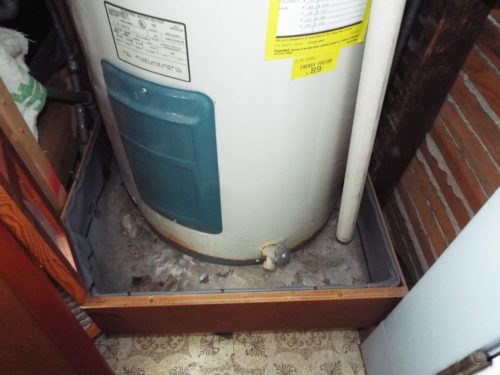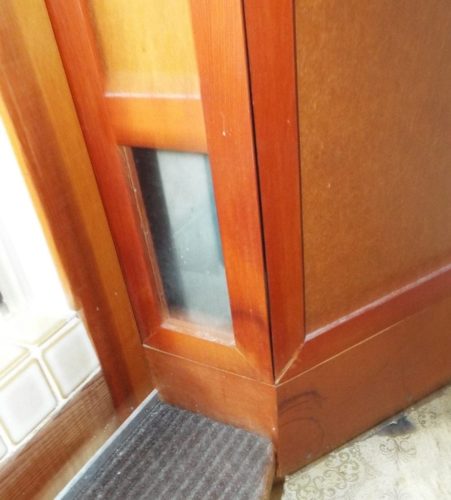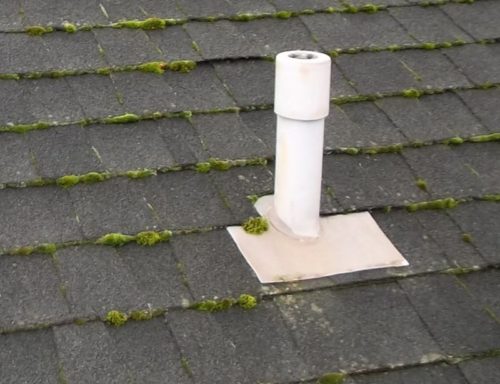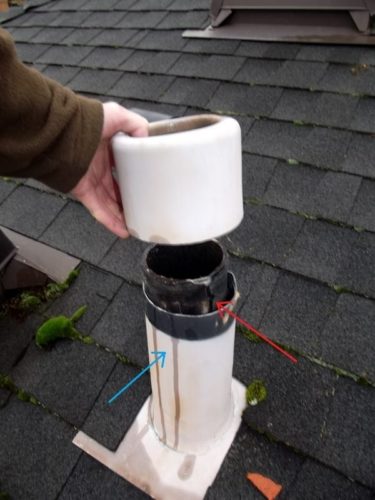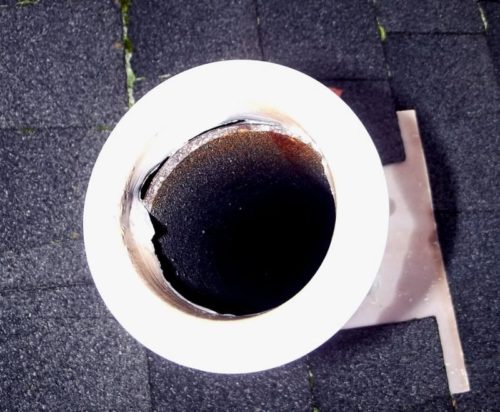Sometimes complicated is not as good as simple - water heater leak pans. Posted: 15 Aug 2015 06:21 PM PDT Everyone knows that it is a good idea to install a leak collection pan under water heater. In fact these At a recent inspection I found the water heater in the following picture installed behind some removable With the panels out of the way one can see the plastic liner that has been created to form a pan The white pipe on the right in the picture (that terminates inside this pan) is the drain for the In Washington State, which follows the Uniform Plumbing Code (UPC), the TPRV drain cannot Another component of the leak pan is that it should have a drain so that any leaks can be safely Whoever installed this water heater had a more complicated means of dealing with monitoring for Sometimes complicated is not as good as simple. By Charles Buell, Real Estate Inspections in Seattle |
| |
Sometimes it is the little details that make all the difference - Posted: 07 Aug 2015 06:33 AM PDT Today's post is about one such little detail. In this case the risk of its being a "big deal" This is a typical lead flashing common on houses in the Northwest. The flashing is made of lead. It is designed to fit over the pipe and be lapped by the shingles Now you might ask, well how much water could that amount to really? If you look at this next picture you can see where the blue arrow points to two water lines that In this next picture we can see "why" this is happening. When they installed the nice In our area of the world, where it can rain or drizzle for weeks on end, it actually can result At any rate, even a half a cup of water a day–or any amount that would not dry in 24 hours I have found several damaged ceilings with "unexplained" past/ongoing water damage from This defect, I might add, could likely not be determined from a ladder at the edge of the roof– By Charles Buell, Real Estate Inspections in Seattle |
| |
Sunday 18 October 2015
Sometimes complicated is not as good as simple
Tuesday 13 October 2015
“Safer, Warmer And Healthier Homes” – Changes To Regulations Affecting Landlords
"Safer, Warmer And Healthier Homes" – Changes To Regulations Affecting Landlords Posted: 12 Oct 2015 01:26 PM PDT by Gemma Dale, www.unconditional.co.nz Back in July, the Government announced changes to the law affecting landlords and tenants. Under new regulations, most landlords will be required to ensure that properties under their management meet certain standards, including effective insulation and the provision of smoke alarms. Theoretically, this legislation is good for both landlords and tenants – on the one hand, it ensures that tenants need not feel forced by market circumstances to live in poorly maintained, unsafe homes. On the other, it gives landlords the incentive to improve their properties, and makes said properties far more attractive rental prospects. However, these new regulations come at an interesting time for the letting market, and not everyone believes that the new regulations will have the impact that they should. In order to fully appreciate the potential consequences of these new laws, it is essential that they be viewed within their current context – particularly with reference to the now thriving rental black market. The Legalities Of Renting Those who rent legitimately, and declare their property interests to the government are naturally subject to rules and regulations – more so under the new laws. They are likely to have a degree of insurance protecting themselves, their business, their property, and their tenants. Furthermore, tenants who rent legally have recourse to legitimate avenues of dispute should they run into problems. Under the new laws, tenants will also be assured of a degree of warmth and safety within their homes as well – something any responsible landlord will usually provide as a matter of course. However, these safety measures and assurances must necessarily come at a price – which will usually be added on to the rent. In addition to this, in many areas of New Zealand (Auckland in particular), demand far exceeds supply when it comes to rental accommodation, meaning that landlords have a distinct advantage when it comes to pricing properties and choosing tenants. All too often, those in need of housing are finding that legitimately rented properties have a price tag which they consider extortionate, particularly when much-hated estate agent fees are thrown into the mix. Feeling exploited and priced out of the market, it is perhaps unsurprising that people are increasingly turning their backs on those who make it their legitimate business to rent out properties, and entering a growing 'black market' of sub-letting and surreptitious private tenancy. The Rental Black Market This 'black market' is not just flourishing in New Zealand – it's doing a roaring trade all over the world. The internet facilitates the illegitimate business of those who sub-let spare rooms, and rent out properties on a private basis without registering with the appropriate governmental authorities. With 'couchsurfing' websites like AirBNB in the vanguard, more and more people are choosing to shun estate agents and legally registered landlords in order to take their chances with rooms and properties advertised on the internet. In part, this movement is facilitated by the popular perception of estate agents and professional landlords as money-grabbing and exploitative – an image not aided by the media. Many people feel that they would far rather take their chances with a private and illegitimate landlord with whom they can deal on a face-to-face and equable basis than a professional agency or landlord whom they perceive to be steeped in greed and liable to exploit them at every opportunity. This is an image which the real estate industry really must work upon if the rental black market is to be combated in any serious way. Ethical Reform Of course, the best way in which to change an image is to act in the way you would like to be perceived. The new regulations, it is hoped, may help in some way to challenge the rental black market by giving tenants assurances of safety which they will certainly lack with unregistered landlords. However, it also indicates a degree of ethical thought and moral conduct with which the real estate industry is not usually associated. While some are still concerned that the new regulations are little more than a sop to tenant demands, others have noted that it may provide a welcome change in the general mode of landlord-tenant relations. In social housing, the required improvements must be put in place before next July. All other properties must meet the new governmental regulations by July 2019. The overall impact that this will have upon the rental market – both legitimate and illegitimate – but it is to be hoped that (assuming that landlords fulfil their obligations correctly) the situation as a whole will improve for everyone. "Gemma (Dale) is a financier turned freelance writer. She is passionate about helping businesses succeed with clever and engaging copy that enlightens and informs the reader. In her limited spare time she also enjoys roller blading, quite often with her energetic spaniel in tow." |
Thursday 1 October 2015
Unconditional.co.nz
Unconditional.co.nz | ||
Fewest homes for sale nationwide for at least eight years Posted: 30 Sep 2015 04:11 PM PDT Market demand continues to push up prices and fuel high turnover AUCKLAND, 1 October 2015 – There are now fewer residential properties listed "Historically, the number of homes for sale tends to be fairly stable, following gradual, Over the last eight years, the number of the homes for sale climbed steadily to a high "We use a metric we call inventory, a measure of supply and demand that indicates "We have only 16.3 weeks of inventory compared to the long-term average of 35 weeks. The current inventory levels across all 19 regions of New Zealand are now below their More new listings, but properties do not stay on market for long "The fact that inventory is so low may seem surprising, given that we have seen an "Low inventory such as this is usually associated with a sellers' market and higher While Realestate.co.nz data for September reveals that the average asking prices in About Realestate.co.nz Realestate.co.nz offers buyers the shortest path to the perfect property. As the official Source: www.realestate.co.nz blog www.unconditional.co.nz Kind regards, Duane Turner duane.turner@abuyerschoice.com |
| |
BNZ boss warns of higher home loan rates
The Bank of New Zealand has posted its half-year profit. Photo/Bevan Conley Increased pressure on bank margins will mean higher home ...

-
New Zealand's housing market has a 40 per cent chance of going bust in the next two years, according to global investment bank Goldman S...
-
Source: Unconditional.co.nz - National house asking prices fall for the first time since April 2016 Posted: 01 Aug 2016 02:10 PM PDT - slo...
-
Source: Unconditional.co.nz Manawatu-Wanganui hits the property sweet spot , Posted: 31 Oct 2016 09:05 AM PDT While demand in the...

